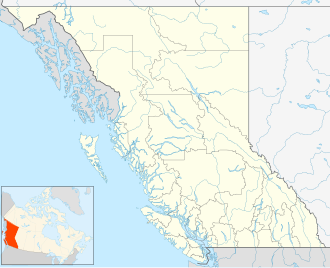Management
The estuary has been historically managed by various organizations since its establishment in 1970, with a focus on local administration and protecting the species that reside within it. The management planning process for the Skwelwil'em Squamish Estuary Wildlife Management Area was carried out in collaboration with the Squamish Nation and with input from parties and sources such as the Squamish Estuary Management Committee, the Ministry of Environment, the BC Wildlife Act, and the Federal Migratory Birds Convention Act. The management goals for the territory are centered around the protection of fish and wildlife, usage of an integrated management approach and related research activities, and acknowledgement of the land's cultural significance to the Squamish First Nation. [5]
Indigenous involvement
The estuary is situated upon the Squamish First Nation, with an agreement in place between them and the province of British Columbia aimed at ensuring a collaborative effort in managing the park, fostering active communications, developing proactive strategies, providing opportunities for the Squamish First Peoples to share their cultural heritage, and acknowledging the relevance of their community's stewardship and partnership initiatives. [5]
Ecology
The wildlife management area encompasses the delta of the Squamish River where it enters Howe Sound. [4]
The Squamish Estuary mixes freshwater from the Squamish River with seawater, forming a unique ecosystem with high productivity and high biodiversity. It contains varied habitats such as marshes, mudflats, intertidal shores, seagrass beds, tidal streams, and barrier beaches. Its geographical features also contribute to water filtration and thus lead to a more pristine marine environment, as well as mitigating flood risks around the region. [5]
Climate change
Estuary ecosystems are particularly vulnerable to the effects of climate change. Increasing temperatures cause sea levels to rise, which not only affects the geography of the estuary due to flooding, but also the salinity levels of the ecosystem due to changes in discharge. Climate change degrades threatens the habitats of native species and erodes plant communities. [5] [8]
Human interaction
The Squamish estuary is an integral part of flood control for the Squamish town site. However, its physical and chemical composition has changed significantly due to human activity. In the 1970s, large quantities of dredge spoils material were deposited into the estuary for a proposed coal port that was blocked by the Department of Fisheries and Oceans and never constructed. [5] [6] Past industrial activity has also resulted in pollution; notably, a former chlor-alkali plant led to mercury contamination of sediments on the southeastern side of the wildlife management area, with most of the contamination residing beyond its boundaries. [5] [9]
Despite these issues, the Squamish Estuary Wildlife Management Area continues to act as an essential part of the local ecosystem and remains highly productive in protecting local wildlife. Although its primary purpose is to ensure a viable habitat for fauna and flora, recreational activities occur throughout the park too, including various trails, wind sports, and hunting and fishing with vehicular access available. [3] [5]
This page is based on this
Wikipedia article Text is available under the
CC BY-SA 4.0 license; additional terms may apply.
Images, videos and audio are available under their respective licenses.


